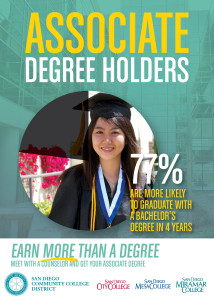Marketing the Associate Degree
By Emily Rogan
June 5, 2015
One California community college district is spreading the word about the importance of earning a two-year degree before transferring.
San Diego Community College District (SDCCD) aims to educate students and faculty about the value of earning an associate degree, even for students planning to transfer to four-year institutions, through a campaign called Earn More Than a Degree. The goal? Administrators hope to boost the number of students who earn their degrees before embarking on their next paths.
“We are better than the state average for completion rates, but behind in producing the number of associate degrees that we should be producing,” says Jack Beresford, director of communications and public relations for SDCCD, which includes Mesa, City and Miramar colleges. (In California, the annual Scorecard tracks completion rates and other student data for the 112 community colleges that make up the California Community College System.)
According to Beresford, about 75 percent of SDCCD students transfer to San Diego State University or to the University of California, San Diego, in La Jolla. Many of those students are just a few credits shy of completing an associate degree.
“One issue is that the perception is that the associate degree is not needed for many of these students. There is an emphasis on transfer to four-year university, often without first earning an associate degree,” Beresford says. Sometimes, even the schools’ counselors might suggest transferring before earning a degree.
How to market an associate degree
The Earn More Than a Degree campaign breaks down what students need to know about getting their associate degrees before moving on. Here are three main points behind the marketing:
- Students who earn an associate degree are 77 percent more likely to earn a bachelor’s degree in four years.
- Students with an associate degree are likely to earn as much as $421,000 more over a working lifetime, compared with someone who has only a high school diploma.
- California recently approved a new set of associate degrees called Associate Degrees for Transfer, which offer guaranteed transfer to a California State University.
 Sharing information via social media, banners, posters, student newspapers, electronic message boards and a website, the campaign is part of a larger strategy that SDCCD Chancellor Constance M. Carroll and her Cabinet are implementing. Their goal: to increase the number of students who graduate from SDCCD with degrees (not just certifications) by 10 percent each year for the next seven years and, ultimately, to double the number of degrees granted over that period.
Sharing information via social media, banners, posters, student newspapers, electronic message boards and a website, the campaign is part of a larger strategy that SDCCD Chancellor Constance M. Carroll and her Cabinet are implementing. Their goal: to increase the number of students who graduate from SDCCD with degrees (not just certifications) by 10 percent each year for the next seven years and, ultimately, to double the number of degrees granted over that period.
Measuring results
The district launched the campaign in March, so it’s too soon to know what the impact will be. But, the campaign is part of the district’s Associate Degree Initiative, which started this past fall. The results so far: a 37 percent increase in degrees awarded this year compared with 2014.
“The early indications are that students are eager to graduate and get into the workplace,” Beresford says.
Though he’s not sure what the other districts are doing along the same lines, Beresford points out that the California Community Colleges Chancellor’s Office set a goal to increase by 2.5 percent the number of students earning associate degrees or transferring. That would translate to 227,247 students statewide in 10 years.
Acknowledging that SDCCD’s goal is more ambitious, Beresford says that his district — the second-largest district in California, and sixth in the nation — wants to remain a leader in secondary education.
“When we looked at our graduates against our peers, it didn’t measure up. This was a reality test for our district; our goal benefits our students and is consistent with our mission that is focused on student success.”







